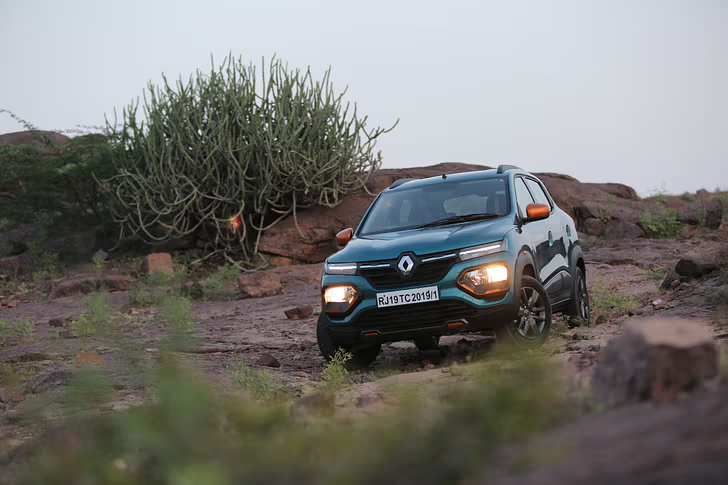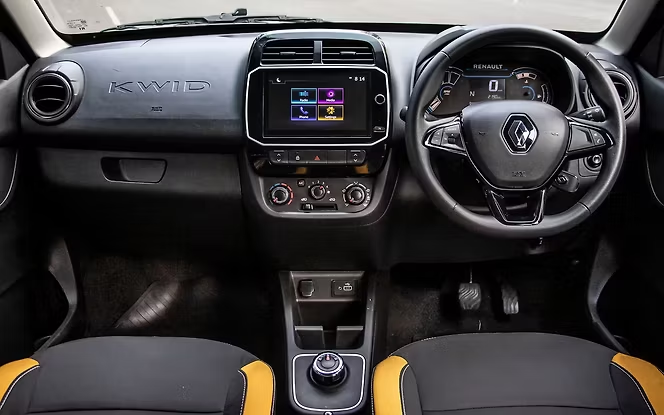The Renault Kwid is a popular entry-level car in India. It draws buyers who want modern looks, good fuel economy, and low cost of ownership. The 2025 model keeps its compact appeal and adds useful updates. In this review, I cover design, cabin space, engine options, fuel efficiency, safety, features, pricing, ownership, pros and cons. I use simple language and short sentences. This article helps you decide whether the Kwid is right for you.
Quick Spec Table — Renault Kwid (India 2025)
| Specification | Renault Kwid (typical petrol variant) |
|---|---|
| Segment | Entry / Budget Hatchback |
| Engine | 1.0-litre three-cylinder petrol |
| Power | ~67 hp (≈ 50 kW) |
| Torque | ~91 Nm |
| Transmission options | 5-speed Manual; 5-speed AMT |
| Mileage (ARAI) | Manual ~21.46 km/l; AMT ~22.3 km/l |
| Real-world mileage | ~16-18 km/l in city + highway mix (AMT) |
| Fuel tank capacity | ~28 litres |
| Ground clearance | ~184 mm |
| Key features | Dual airbags, ABS + EBD, infotainment, parking sensors, rear camera, digital instrument cluster |
| Price range (ex-showroom) | ~₹4.70 lakh base to ~₹6.5-6.6 lakh top trim (Petrol) |
| Safety features | Dual airbags; stability control on many variants; traction control; seat belt reminders; reverse parking camera/sensor |
First look & what’s changed in 2025
The Kwid for 2025 hasn’t changed drastically. It retains its tall-boy hatchback stance. The front fascia has mild styling tweaks. Headlamps, grille and bumper are refined to look sharper. Interiors get minor updates. Renault has improved safety features in recent trims. Price cuts under recent tax (GST) reforms have made it more affordable. These moves make the Kwid more competitive today.
Exterior design & road presence

From outside, Kwid stands out among small hatches. Its ground clearance is good. It has tall ride height, helping with speed breakers and uneven roads. The body is compact, which helps in traffic and tight parking. Alloy wheels (in higher trims), sporty dual-tone roof or body accents (in Climber trims) raise its visual appeal. The headlamps and tail lamps have clean designs. In city traffic, Kwid looks fresh. On highways, wind noise is more noticeable due to its size and shape.
Cabin quality, space & comfort

The Kwid cabin reflects its budget status, but it offers what owners need. Materials are hard plastics mostly, but finishing is decent. Seats are simple, cloth upholstery except in top trims where texture and design are better. Front seats are comfortable for small journeys; long drives get tiring due to thin padding. Rear seats are usable for two adults; three will be tight. Legroom is okay for its class. Boot space is reasonable for day-to-day shopping or airport bags. Small storage spaces exist: door pockets, glovebox, small dashboard cubby. Air conditioning works well in hot weather (though cooling efficiency depends on trim).
Also Read Renault Kiger 2025 Review — Compact SUV That Packs Value, Space and Safety
Engine, transmission & performance
The Kwid offers a 1.0-litre three-cylinder petrol engine. It produces around 67 hp (or bhp) and about 91 Nm torque. It is paired with either a 5-speed manual or a 5-speed AMT (automated manual transmission). The manual gives slightly better control and feels livelier in city driving. The AMT is more convenient in traffic but slower during overtakes and uphill runs. Acceleration is modest. The car is not built for speed. It works best with light loads and careful gear shifting. On highways, keeping rpm up is necessary for smooth overtakes.
Fuel efficiency & mileage
Fuel economy is one of Kwid’s biggest strengths. According to ARAI figures, the manual version gives around 21.46 km/l, and the AMT gives around 22.3 km/l under test conditions. Real-world numbers are lower, especially in city traffic, AC use, and heavy load—but still good for its segment. A recent test for AMT showed around 16.8 km/l in city, and highway performance raises the average. Fuel tank capacity is about 28 litres. This gives decent driving range for daily use and occasional highway trips.
Features & technology
Renault packs a fair amount of features into the Kwid. Even base or lower trims have essentials. Standard features include digital instrument cluster, touchscreen infotainment (in many trims), Android Auto and Apple CarPlay (in mid/higher trims), reverse parking sensors, rear camera (in some variants). Higher trims offer better infotainment screens, sportier seat designs, dual-tone colour schemes, alloy wheels, ambient lighting, and roof rails in Climber editions. Safety features include ABS + EBD, driver and passenger airbags, seat belt reminders, rear parking aids. Renault also includes tyre pressure monitoring system (TPMS), hill start assist in AMT trims, and a good set of safety-related warnings.
Safety & crash ratings
Safety is a concern with Kwid in some tests. A past ASEAN NCAP crash test for a base variant with only a driver airbag resulted in a zero-star rating. The tested model lacked ISOFIX mounting, and safety assist technologies (SAT) were missing. Adult and Child Occupant Protection scores were low. Renault has since improved safety on many variants. On India’s official safety website, Kwid now has dual airbags (driver and passenger) in most trims, stability control (on many variants), traction control, rear seat belt reminder, and other safety features. Still, because some variants lack higher protection equipment, buyers need to check variant-wise safety features carefully before buying.
Real ride, handling, NVH (noise, vibration, harshness)
On city roads, the Kwid rides reasonably for its price. Suspension handles small bumps and moderate potholes fairly well. But large speed breakers and highly uneven patches show its limitations (harshness and bounce). Steering is light, making parking and low-speed manoeuvres easy. At highway speeds, engine noise and wind noise rise. AMT version shows lag sometimes under hard acceleration. NVH is not premium. For four adults, ride comfort drops when car is fully loaded.
Pricing, variants, trims and value
Renault offers Kwid in multiple trims: RxE, RxL, RxT, Climber etc. The pricing ex-showroom in Delhi is roughly ₹4.70 lakh for base trims. Top trims with AMT and more equipment cost more (around ₹6.5-6.6 lakh in some markets). The recent GST 2.0 tax benefit led to price cuts on Kwid in many regions, making it more affordable. This improves its value. For many, the base/ mid trims offer reasonable equipment and low running costs. The Climber trim adds style cues (sporty seats, roof rails, body accents) but the price rises.
Practical ownership & costs
Owning a Kwid is generally affordable. Insurance, maintenance, spare parts are relatively cheaper due to low complexity of engine and smaller size. Fuel cost is low, especially for manual or AMT petrol. Resale value is modest—but acceptable in the budget hatchback segment. Service network of Renault is decent in cities; in smaller towns, fewer service centres may cause longer wait times. Key expenses include tyres (higher wear if roads are bad), clutch wear (manual), battery and periodic servicing. AMT versions may require more frequent upkeep of transmission mechanics because of their complexity compared with manual.
Pros and cons
Pros
- Excellent fuel economy for everyday use.
- Very affordable on purchase price in its segment.
- Compact size helps with traffic and parking.
- Decent feature content in higher trims.
- Stylish design and good ground clearance for the price.
Cons
- Performance is modest. Not built for highway overtakes or heavy loads.
- Safety rating (in some tests) is weak; base variants lack some safety aids.
- NVH is average; cabin noise and vibration can become noticeable.
- Ride comfort drops with full load.
- AMT version lags slightly in responsiveness compared with manual.
FAQs — Frequently Asked Questions
1. What is the mileage of Renault Kwid?
The ARAI figures are about 21.46 km/l for manual petrol and about 22.3 km/l for AMT petrol. Real-world combined mileage often falls around 16-18 km/l for AMT and somewhat better for manual.
2. How much does Kwid cost in India in 2025?
The launch price for base trims stands around ₹4.70 lakh (ex-showroom). Top trims with more features cost up to around ₹6.5-6.6 lakh in many cities. GST reductions benefit many buyers.
3. Is Kwid safe enough today?
Safety is improved in newer and higher variants—dual airbags, ABS, stability control, seatbelt reminders and other aids. But crash tests in earlier versions showed weak performance. Before buying, check the variant’s safety features specifically.
4. Manual or AMT—which is better?
Manual is more responsive and gives better control, especially for driving in mixed traffic or steep roads. AMT gives more comfort and ease in heavy traffic. But AMT may lag in acceleration and feel less sharp.
5. How does Kwid compare with rivals like Maruti Alto, Tata Tiago, or Hyundai Santro?
Kwid wins on looks, ground clearance, and style touches in higher trims. Fuel efficiency is competitive. But rivals may offer better safety in top trims, more refined ride, or stronger build. If budget is tight and you prioritize cost of ownership, Kwid is strong. If you want higher safety and comfort, spend a bit more for stronger rivals.
Conclusion — Is the Renault Kwid right for you?
The Renault Kwid 2025 is a solid choice if you want a simple, budget-friendly hatchback with decent fuel efficiency, compact size, and modern features. It shines in city driving, short commutes, and among those who want lower running costs.
If your priorities include high performance, strong acceleration, a premium-quiet cabin, or top safety across all variants, you may need to plan for a more expensive model or consider higher trims and features.
For its segment, the Kwid delivers what most entry-level buyers look for: low price, decent mileage, easy maintenance, and brand value. If that matches your needs, the Kwid should be on your shortlist. Make sure to test drive the variant you plan to buy. Confirm safety features and on-road price. That will help you get the best value for your money.


















